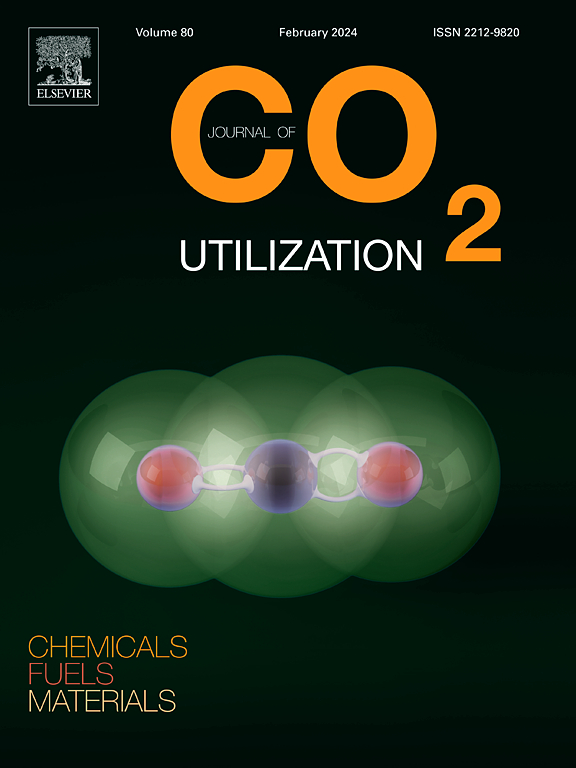羧酸阴离子对基咪唑离子液体吸收CO2机理的影响
IF 7.2
2区 工程技术
Q1 CHEMISTRY, MULTIDISCIPLINARY
引用次数: 0
摘要
大气二氧化碳(CO 2)水平的降低取决于诸如减少化石燃料使用、采用可再生能源以及利用CO 2捕获和利用技术等战略的实施。虽然直接空气捕获(DAC)为全球减缓提供了重要机会,但工业努力主要集中在燃烧前、氧燃料和燃烧后捕获方法上,以提高环境的可持续性。然而,二氧化碳再利用的经济可行性仍然是一个重大问题,开发创新的解决方案势在必行。本研究比较了羧酸阴离子对咪唑衍生离子液体(ILs)吸收CO2过程的影响。对甲酸1-丁基-3-甲基咪唑([BMIm][HCOO])、乙酸1-丁基-3-甲基咪唑([BMIm][OAc])和丙酸1-丁基-3-甲基咪唑([BMIm][C3H5OO])进行了分析。通过核磁共振(NMR)和衰减全反射红外光谱(ATR-IR)量化IL-CO 2加合物的形成来评估捕获过程的有效性。此外,本文利用密度泛函理论(DFT)和COSMO模型研究了用于CO2吸收过程的离子液体中质子从阳离子[BMIm]+向羧酸阴离子转移的自发性差异。基于实验和建模数据,[BMIm][OAc]被确定为最佳IL候选物,在30°C和1 bar下,CO2的摩尔分数为0.203,而[BMIm][HCOO]为0.083,[BMIm][C3H5OO]为0.190。此外,理论模拟通过计算酸去质子化平衡常数来支持这些结果,其中[BMIm][OAc]得到的值最高。本文章由计算机程序翻译,如有差异,请以英文原文为准。
Influence of the carboxylate anion on the CO2 absorption mechanism using based-imidazolium ionic liquids
The reduction of atmospheric carbon dioxide (CO₂) levels is contingent upon the implementation of strategies such as the curtailment of fossil fuel usage, the adoption of renewable energy sources, and the utilization of CO₂ capture and utilization technologies. Although direct air capture (DAC) presents a significant opportunity for global mitigation, industrial efforts have primarily concentrated on pre-combustion, oxyfuel, and post-combustion capture methods to enhance environmental sustainability. Nevertheless, the economic viability of CO₂ reuse remains a significant concern, and the development of innovative solutions is imperative. In this study, the influence of the carboxylate anion on CO2 absorption process using imidazolium-derived ionic liquids (ILs) is compared. 1-Butyl-3-methylimidazolium formate ([BMIm][HCOO]), 1-butyl-3-methylimidazolium acetate ([BMIm][OAc]), and 1-butyl-3-methylimidazolium propionate ([BMIm][C3H5OO]) have been analyzed. The efficacy of the capture process was assessed by quantifying the formation of an IL-CO₂ adduct using nuclear magnetic resonance (NMR) and attenuated total reflection infrared spectroscopy (ATR-IR). Furthermore, this work studies, using Density Functional Theory (DFT) and COSMO modelling, the difference in the spontaneity of the proton transfer from the cation [BMIm]+ to the carboxylate anions of the ionic liquids used in CO2 absorption process. Based on experimental and modelling data, [BMIm][OAc] was identified as the optimal IL candidate, presents a CO2 molar fraction absorbed at 30 °C and 1 bar of 0.203, compared to 0.083 for [BMIm][HCOO] and 0.190 for [BMIm][C3H5OO]. Moreover, theoretical simulations support these results with the calculation of the acid deprotonation equilibrium constants with the highest value being obtained for [BMIm][OAc].
求助全文
通过发布文献求助,成功后即可免费获取论文全文。
去求助
来源期刊

Journal of CO2 Utilization
CHEMISTRY, MULTIDISCIPLINARY-ENGINEERING, CHEMICAL
CiteScore
13.90
自引率
10.40%
发文量
406
审稿时长
2.8 months
期刊介绍:
The Journal of CO2 Utilization offers a single, multi-disciplinary, scholarly platform for the exchange of novel research in the field of CO2 re-use for scientists and engineers in chemicals, fuels and materials.
The emphasis is on the dissemination of leading-edge research from basic science to the development of new processes, technologies and applications.
The Journal of CO2 Utilization publishes original peer-reviewed research papers, reviews, and short communications, including experimental and theoretical work, and analytical models and simulations.
 求助内容:
求助内容: 应助结果提醒方式:
应助结果提醒方式:


